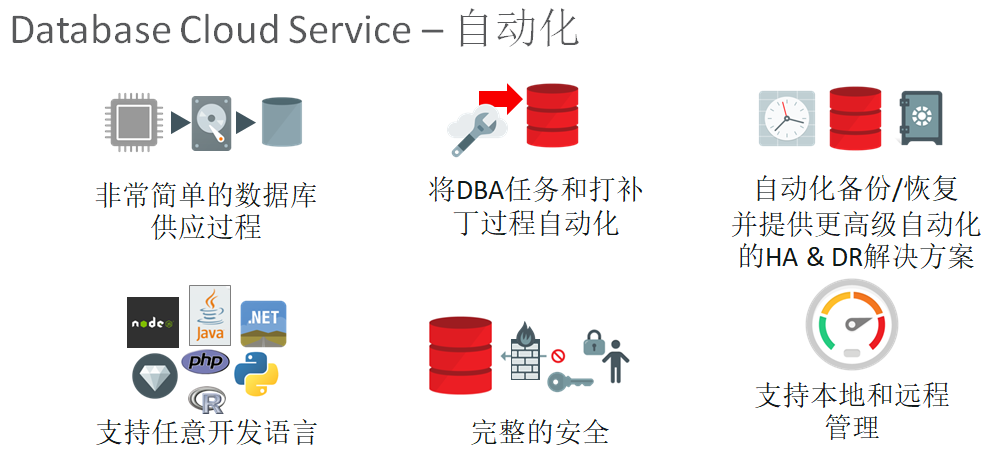Oracle数据库云服务使您能够在云中快速部署Oracle数据库,每个数据库部署包含一个Oracle数据库或由Primary Oracle数据库和Standby Oracle数据库组成的Oracle Data Guard配置。创建数据库部署时,Database Cloud Service使用各种Oracle Cloud基础结构服务提供的计算,存储和网络资源创建计算节点以托管数据库,以简化日常数据库维护和管理操作。您可以完全访问Oracle数据库提供的功能和操作。

数据库部署完成后,会启动数据库。可以设置数据库自动备份。具有root权限和对Oracle数据库的完全管理权限,可以对自动维护设置进行任何更改。
与许多Oracle云平台服务一样,数据库云服务依赖于名为Platform Service Manager(PSM)的Oracle云的底层组件来提供其服务控制台及REST API。Oracle Cloud的Platform Service Manager(PSM)组件使用SSH访问组成数据库部署的计算节点,以便执行预定义的Platform Service操作,如备份和修补等。您可以从Web控制台或REST API启动这些Platform Service操作。每个数据库部署使用单独的SSH密钥对来执行此内部通信。密钥仅在程序控制下使用,Oracle员工无法直接访问。由计算节点上的Platform Service Manager(PSM)组件执行的所有SSH操作都将被记录并可以进行审计。除非您明确提供对密钥的访问以进行故障排除,否则Oracle云操作团队无法访问驻留在您的计算节点上的任何SSH密钥,也无法访问您的计算节点。
除了基于Web的Oracle数据库云服务控制台的功能外,数据库云服务还提供了以下工具:
简单的自动备份:使用bkup_api实用程序(使用Oracle Real Application Clusters的部署中的raccli)执行按需备份并更改自动备份的配置方式。
简单的自动恢复:使用dbaascli实用程序的orec子命令(使用Oracle Real Application Clusters的部署上的raccli)从备份进行恢复。
简单的自动修补:使用dbaascli实用程序的patch子命令(在使用Oracle Real Application Clusters的部署上使用raccli)来应用修补程序。
SQL Developer Web:使用基于Oracle SQL Developer Web浏览器的应用程序来监视Oracle数据库和计算资源。
Oracle数据库云操作系统用户
| 用户名 | 描述 |
|---|---|
|
opc |
The system administrator account you use to connect to the compute node using SSH. This user can use thesudocommand to perform operations that require root-user access. |
|
oracle |
The Oracle Database administrator account you use to access the system and perform non-root database administration tasks. A home directory,/home/oracle, is created for this user. This user cannot use thesudocommand to perform operations that require root-user access. Additionally, by default you cannot connect as this user to the compute node using SSH. You can add the public key to the user’s$HOME/.ssh/authorized_keysfile to grant persistent SSH access, or you can connect as theopcuser and then use thesudo -scommand to start a root-user command shell, followed by ansu - oraclecommand to switch to theoracleuser. |
|
grid |
The Oracle Grid Infrastructure administrator account you use to perform ASM, ACFS, and clusterware administration tasks. A home directory,/home/grid, is created for this user. This user cannot use thesudocommand to perform operations that require root-user access. Additionally, by default you cannot connect as this user to the compute node using SSH. You can add the public key to the user’s$HOME/.ssh/authorized_keysfile to grant persistent SSH access, or you can connect as theopcuser and then use thesudo -scommand to start a root-user command shell, followed by ansu - gridcommand to switch to thegriduser. |
|
root |
The root administrator for the system. You do not have direct access to this account. To perform operations that require root-user access, use thesudocommand as theopcuser. |
For Oracle Database 18c,/u01/app/oracle/product/18.0.0/dbhome_1
For Oracle Database 12c Release 2,/u01/app/oracle/product/12.2.0.1/dbhome_1
For Oracle Database 12c Release 1,/u01/app/oracle/product/12.1.0.2/dbhome_1
For Oracle Database 11g Release 2,/u01/app/oracle/product/11.2.0.4/dbhome_1
|
存储空间设置 |
描述 |
|---|---|
|
boot (four volumes, one for each compute node) |
25 GB volume for operating system files, user directories and swap space. This volume appears as the/dev/xvdbblock device on each compute node. |
|
bits (four volumes, one for each compute node) |
70 GB volume for Oracle Database and Oracle Grid Infrastructure software. This volume appears as the/dev/xvdcblock device on each compute node. |
|
data (two volumes, one for each cluster database) |
Shared storage for database files. GB size equal to the value provided in the Usable Data Storage field during the database deployment creation process, with a minimum of 15 GB. This volume appears as the/dev/xvddblock device on each compute node. |
|
fra (two volumes, one for each cluster database) |
Shared storage for the fast recovery area. GB size depends on the choice of Backup Destination during the database deployment creation process:
This volume appears as the/dev/xvdeblock device on each compute node. |
|
redo (two volumes, one for each cluster database) |
20 GB shared storage volume for redo logs. This volume appears as the/dev/xvdfblock device on each compute node. |
| 文件系统挂载点 | 描述 |
|---|---|
|
swap |
Swap space; 4 GB allocated from the boot Compute Cloud storage volume. |
|
/(root) |
Operating system files; 16 GB allocated from the boot Compute Cloud storage volume. |
|
/boot |
Operating system kernel; 500 MB allocated from the boot Compute Cloud storage volume. |
|
/u01 |
Oracle product software; the entire bits Compute Cloud storage volume. |
|
/u02 |
Oracle Database data storage; the entire data Compute Cloud storage volume. An Oracle ASM diskgroup named DATA is created on the storage volume and Oracle ACFS is used to mount it. |
|
/u03 |
Database backup storage; the entire fra Compute Cloud storage volume. An Oracle ASM diskgroup named FRA is created on the storage volume and Oracle ACFS is used to mount it. |
|
/u04 |
Database redo logs; the entire redo Compute Cloud storage volume. An Oracle ASM diskgroup named REDO is created on the storage volume and Oracle ACFS is used to mount it. |
创建云上Oracle数据库
Creating a Database Deployment
Creating a QuickStart Database Deployment
Creating a Customized Database Deployment
Creating a Database Deployment Using a Cloud Backup
Creating a Clone Database Deployment from a Snapshot
Creating a Hybrid DR Deployment
Viewing All Database Deployments
Viewing Detailed Information for a Database Deployment
Viewing Activities for Database Deployments in an Identity Domain
Stopping, Starting and Restarting a Database Deployment
Creating and Managing IP Reservations
Creating and Managing Snapshots of a Database Deployment
迁移到Oracle数据库云的方法
Data Pump Conventional Export/Import
Data Pump Transportable Tablespace
RMAN Cross-Platform Transportable PDB
RMAN Cross-Platform Transportable Tablespace Backup Sets
RMAN Transportable Tablespace with Data Pump
RMAN CONVERT Transportable Tablespace with Data Pump
SQL Developer and INSERT Statements to Migrate Selected Objects
访问云上Oracle数据库
Connecting to a Compute Node Through Secure Shell (SSH)
Accessing Enterprise Manager Database Express 18c
Accessing Enterprise Manager Database Express 12c
Accessing Enterprise Manager 11g Database Control
Connecting Remotely to the Database by Using Oracle SQL Developer
Connecting Remotely to the Database by Using Oracle Net Services
Copying Files to or from a Database Cloud Service Database Deployment
云上Oracle数据库管理
Adding Temporary Storage to a Database Deployment
Updating the Cloud Tooling on Database Cloud Service
Administering a Data Guard Configuration
Preparing 12.2 Database Deployments for Patching
Applying Linux OS Security Patches
Administering Oracle REST Data Services (ORDS)
Loading Data into the Oracle Database on Database Cloud Service
Tuning Oracle Database Performance on Database Cloud Service
Monitoring and Managing Oracle Database on Database Cloud Service
Managing the Log and Diagnostic Files on Database Cloud Service
云上Oracle数据库备份
About Backing Up Database Deployments on Database Cloud Service
Viewing Backup Configuration Information
Updating the Password for Backing Up to the Storage Cloud
Customizing the Current Backup Configuration
Enabling and Reconfiguring the Automatic Backups Feature
Disabling and Re-enabling Scheduled Backups
Restoring from the Most Recent Backup
Restoring from a Specific Backup
Restoring to a Specific Point in Time
Recreating an Unrecoverable Database Deployment From a Backup to Cloud Storage
云上Oracle数据库云打补丁
Checking Prerequisites Before Applying a Patch
Rolling Back a Patch or Failed Patch
Applying a Patch to a Test Deployment
云上Oracle数据库云的组件和选项
Using Oracle Real Application Clusters (RAC) in Database Cloud Service
Using Oracle Data Guard in Database Cloud Service
Using Oracle Multitenant in Database Cloud Service
Using Oracle Database Vault in Database Cloud Service
Using Oracle Application Express in Database Cloud Service
Using Oracle SQL Developer Web in Database Cloud Service
Using Oracle Enterprise Manager Cloud Control with Database Cloud Service
Using Oracle GoldenGate Cloud Service with Database Cloud Service
云上Oracle数据库管理工具dbasscli,使用dbaascli实用程序,您可以做
更改数据库用户的密码
启动和停止数据库
启动和停止Oracle Net监听
检查Oracle Data Guard配置的状态
在Oracle Data Guard配置中执行切换和故障转移
数据库打补丁
恢复数据库
dbaascli subcommand subcommand-options
database
bounce – shuts down and then restarts the database instance.
changepassword – changes the password of the specified user.
start– starts the database instance and opens the database.
status – displays the open mode of the database and additional information about the database deployment.
stop – shuts down the database instance.
dataguard
failover – performs a manual failover.
reinstate – reinstates a failed primary database.
status – checks the status of the configuration.
switchover – performs a switchover operation.
dbpatchm
apply – applies the patch.
clonedb – applies a patch to a test deployment.
list_patches – displays a list of available patches.
list_tools – checks whether any cloud tooling updates are available.
prereq – checks the prerequisites of a patch.
rollback – rolls back the last deployment patch.
switchback – restores database software to a prior state.
toolsinst – downloads and applies the patch containing the cloud tooling update.
dv
off – disables Oracle Database Vault.
on– enables Oracle Database Vault.
gg
setup – configures the database as a valid replication database.
status – indicates whether the database has been configured as a valid replication database.
listener
bounce – stops and restarts the listener.
start – starts the listener.
status – displays the status of the listener, including a summary of listener
configuration settings, listening protocol addresses, and a summary of
services registered with the listener.
stop – stops the listener.
netsec
config – configures network encryption and network integrity.
config encryption– configures network encryption.
config integrity – configures network integrity.
status – displays network encryption and network integrity configuration information.
orec
duplicate – updates the standby database in a Data Guard configuration.
keep list – lists the available long-term backups.
keep tag – restores a specific long-term backup and performs recovery.
latest – restores the most recent backup and performs complete recovery.
list – lists the available normal backups.
pitr – restores a specific normal backup and performs recovery.
scn – restores the most recent backup and performs recovery through the specified SCN.
patch
db apply – applies the database patch.
db cleanup – removes temporary files created during database patching operations.
db list – displays a list of available database patches.
db prereq – checks whether any database updates are available.
db switchback – rolls back the last database patch.
os apply – applies the OS patch.
os list – displays a list of available OS patches.
tools apply – downloads and applies the patch containing the cloud tooling update.
tools auto disable – disables automatic cloud tooling updates.
tools auto enable – enables automatic cloud tooling updates.
tools auto execute – downloads and applies the patch containing the latest cloud tooling update.
tools auto status – checks whether automatic cloud tooling updates are enabled or disabled.
tools list – checks whether any cloud tooling updates are available.
tde
rotate masterkey – changes (rotates) the master encryption key.
status – displays information about the software keystore, including the type and status.
云上Oracle数据库管理工具raccli
Subcommand
Subcommand Options
使用该工具可以执行RAC各种生命周期和管理操作,包括
备份数据库
从备份中恢复数据库
更改自动备份的配置
数据库补丁
更改安全功能的配置
跟踪作为异步作业执行的长时间运行操作的进度和完成情况
raccli subcommand subcommand-options
apply patch: applies a patch to the Grid Infrastructure or Oracle Database home.
clean backup: deletes any unnecessary backups or backup pieces as determined by the backup configuration’s recovery windows for local and cloud backups.
create backup: creates a backup of the configuration files, inventory configuration files, Grid Infrastructure and Oracle Database homes, database, and tooling metadata.
create recovery: initiates database recovery.
describe job: provides information about the progress and status of a long-running operation.
describe system: provides information about the installation of Grid Infrastructure, Oracle Database, and the RDK cloud tooling.
failover dataguard: performs a manual failover to the standby database in your Data Guard configuration.
list backup: provides a list and status of all the backup jobs that have been submitted through theraccliutility.
list backupconfig: provides a list of the backup configuration settings.
list jobs: provides a list of all the jobs that have been submitted through theraccliutility.
list recovery: provides information about recovery jobs.
reinstate dataguard: reinstates a failed primary database as a standby database after a failover.
status dataguard: displays status information about the Data Guard configuration.
switchover dataguard: performs a switchover to the standby database in your Data Guard configuration.
update backupconfig: updates the backup configuration.
update databasepassword: updates the password in the keystore (wallet) and optionally updates the password for theSYSandSYSTEMusers.
update netsec: updates the Oracle Net security configuration.
update rdk: updates the cloud tooling on the Database Cloud Service deployment.
update server: checks for and corrects any configuration issues related to the Linux OS on a compute node of the deployment.
update tde: enables transparent data encryption (TDE) and rotates the TDE key.
Oracle数据库云管理工具dbpatchmdg
使用dbpatchmdg实用程序,可以列出可用的补丁,检查节点是否已准备好进行修补,应用补丁,回滚补丁等
云上Oracle数据库监控工具
截至2018年5月,Oracle DBaaS Monitor已退役,开始使用Oracle SQL Developer Web。 从2018年5月开始,单实例数据库的新Oracle数据库云服务数据库部署包括SQL Developer Web而不是DBaaS Monitor。 如果您有较旧的数据库部署,则应尽快将DBaaS Monitor替换为SQL Developer Web。
通过本地数据库管理工具oracle-dbcs-cli管理云上数据库
您可以在本地Linux计算机上使用oracle-dbcs-cli实用程序连接到Oracle Cloud,并在Oracle Database Cloud Service部署上执行各种生命周期和管理操作。当前这个工具不支持Oracle Real Application Clusters的数据库部署。要运行oracle-dbcs-cli实用程序,请首先导航到安装该实用程序的目录。 然后运行以下形式的命令
./oracle-dbcs-cli -help | -ver | subcommand subcommmand-options
注意:请勿使用halt,shutdown或shutdown -h命令关闭计算节点。 这样做将无限期地停止计算节点,并且需要Oracle Cloud系统管理员手动干预才能重新启动计算节点。
Reference
https://docs.oracle.com/en/cloud/paas/database-dbaas-cloud/index.html
http://www.oracle.com/technetwork/database/database-cloud/public/downloads/index.html

